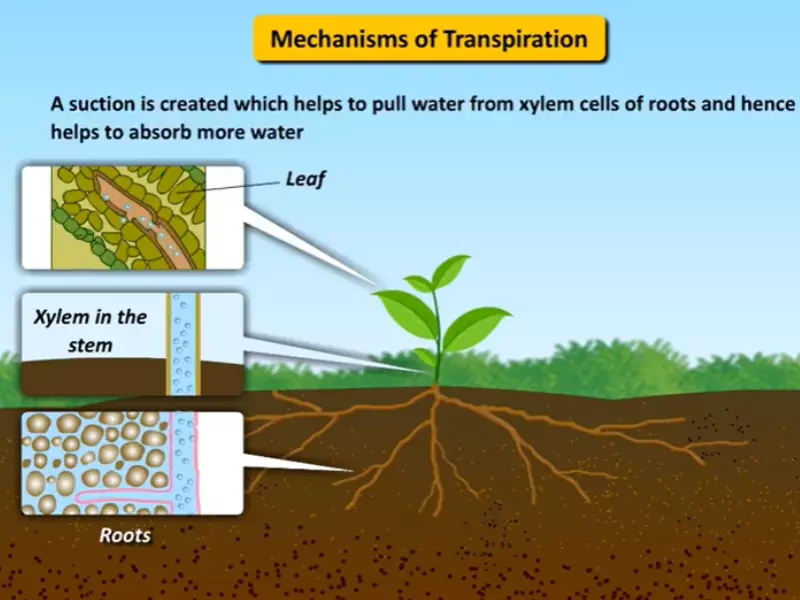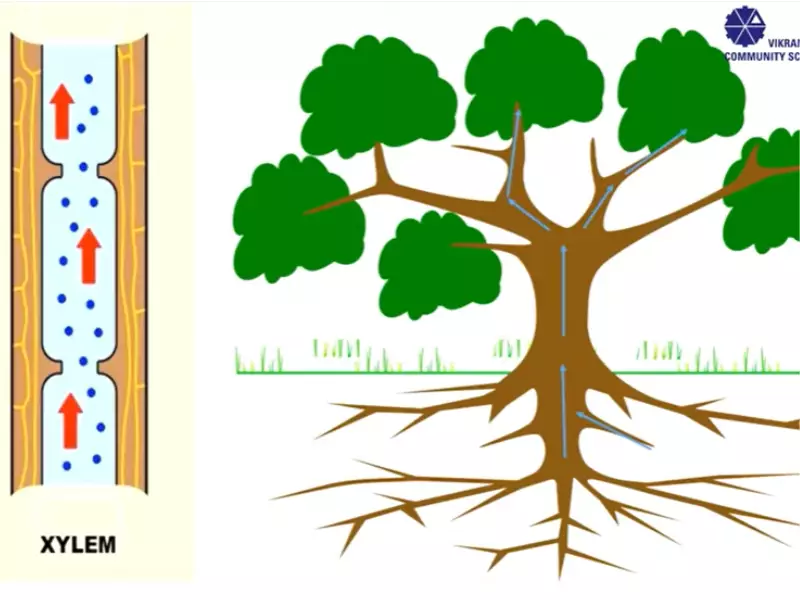Water movement within plants is a marvel of nature’s engineering, crucial for their survival and growth. This process hinges on two fundamental phenomena: capillary action and transpiration pull. Each plays a pivotal role in the complex system that allows plants to thrive by transporting water from the roots to the leaves, despite the pull of gravity.
Capillary action is a physical process where water moves up narrow spaces without the assistance of, and in opposition to, external forces like gravity. Transpiration pull, on the other hand, is a biological process driven by the evaporation of water from plant leaves, creating a suction force that draws water upward through the plant’s vascular system. Together, these processes enable plants to distribute water and nutrients efficiently from the soil to their furthest extremities.
Understanding these mechanisms provides insights into plant biology, agriculture, and ecology, highlighting the intricate balance between physical laws and biological functions. The synergy between capillary action and transpiration pull illustrates nature’s sophistication in sustaining life, ensuring that plants can access the water essential for photosynthesis, nutrient transport, and growth.

Capillary Action
Concept Overview
Capillary action is a phenomenon where liquid moves through or along another medium despite external forces such as gravity. This ability is crucial in nature and technology, exemplified by water’s movement through narrow spaces in soil or within plants. The significance of capillary action extends beyond mere observation; it is fundamental to various biological and ecological processes, ensuring the sustenance of plant life and, by extension, ecosystems.
Definition and Basic Explanation
At its core, capillary action occurs due to the adhesion of water molecules to the walls of a narrow tube or porous material, coupled with cohesion among water molecules themselves. These forces collectively enable water to travel upward against gravity, a sight commonly observed but often not pondered upon. This mechanism is not limited to scientific labs or controlled environments but is a routine occurrence in nature, playing a pivotal role in the survival of plants and the maintenance of ecological balance.
Role in Water Movement in Plants
Plants rely on capillary action to transport water from their roots to leaves and other parts. This movement is not just about hydration but also the transportation of nutrients essential for plant growth and development. The capillary action’s efficiency is vital for plants, especially in arid conditions, where water conservation and effective distribution become paramount.
Mechanism
Physics Behind Capillary Action
The science behind capillary action lies in the balance between cohesive and adhesive forces. When the adhesive force between water molecules and the surface of a narrow tube (or plant vessels like xylem) outweighs the cohesive forces among the water molecules, water rises. The capillarity of a material—its ability to allow capillary action—depends on its pore size and the liquid’s surface tension.
Factors Affecting Capillary Action in Plants
Several factors influence the efficiency and extent of capillary action in plants, including:
- Pore size of the plant vessels: Finer tubes facilitate greater rise.
- Surface tension of water: Higher tension increases capillary action.
- Temperature: Generally, as temperature increases, capillary action speeds up, due to reduced viscosity of water.
- Humidity: Ambient conditions can affect the evaporation rate, indirectly influencing capillary movement.
Examples in Nature
Capillary Action Outside of Plants
Beyond the realms of flora, capillary action is observable in various natural and human-made settings. For instance, the way water spreads through a paper towel or climbs up the fibers of a cloth showcases capillary action at work. These examples illustrate the ubiquity and importance of this physical phenomenon in everyday life and the natural world.
Relevance to Human-Made Systems
Capillary action finds applications in engineering, medicine, and technology. In inkjet printers, capillary action helps draw ink from the reservoir to the paper. In medical diagnostics, it’s employed in capillary tubes to analyze blood samples. The principle is also used in constructing efficient water transport systems and in the field of soil science to understand and manage irrigation practices better.
Transpiration Pull
Concept Overview
Transpiration pull is a vital mechanism that plants use to transport water from roots to leaves, leveraging the evaporation of water from leaf surfaces. This process not only aids in nutrient distribution throughout the plant but also plays a significant role in the regulation of temperature and maintenance of structural integrity through turgor pressure.
Definition and Basic Explanation
Transpiration pull is essentially a suction force generated as water evaporates from the stomata of leaves, creating a negative pressure within the xylem channels. This negative pressure is powerful enough to pull water upward from the roots, overcoming gravitational pull and resistance due to friction.
Role in Water Movement in Plants
This biological process is critical for the upward movement of water, ensuring that every part of the plant receives the moisture and nutrients dissolved in water. Transpiration pull is crucial for the survival of tall trees, where simple diffusion would be insufficient to transport water to the highest leaves.
Mechanism
How Transpiration Pull Works
Transpiration pull’s mechanism is closely tied to the physical properties of water, particularly cohesion and tension. The continuous column of water molecules from roots to leaves is maintained due to cohesive forces, while the evaporation of water from the leaves generates the necessary tension to pull this column upward.
Factors Affecting Transpiration Pull
Several external and internal factors influence transpiration pull, including:
- Temperature: Higher temperatures increase evaporation rates, enhancing transpiration pull.
- Humidity: Lower ambient humidity levels facilitate greater water evaporation, thereby strengthening the transpiration pull.
- Wind: Air movement can increase transpiration by removing water vapor, enhancing the pull.
- Soil water availability: Sufficient water in the soil is essential for transpiration pull to occur effectively.
Examples in Nature
Impact on Nutrient Uptake
Transpiration pull not only facilitates water movement but also plays a critical role in nutrient uptake from the soil. As water is drawn into the roots and moves upward, it carries dissolved minerals and nutrients essential for plant growth.
Role in Ecosystem Balance
By influencing water and nutrient distribution in plants, transpiration pull contributes to the overall health and productivity of ecosystems. It is a fundamental process in the water cycle, affecting local and global climatic patterns and supporting biodiversity.

Key Differences
Basic Principles
Capillary action and transpiration pull are both fundamental in water movement within plants but operate on different principles. Capillary action is primarily driven by the forces of cohesion and adhesion allowing water to move through narrow spaces against gravity. In contrast, transpiration pull relies on the evaporation of water from the leaves creating a negative pressure that draws water upward through the plant’s xylem.
Contrasting Capillary Action and Transpiration Pull
While both processes are crucial for the upward movement of water, their operational mechanisms set them apart. Capillary action is a passive process that can occur in any narrow space irrespective of living systems. On the other hand, transpiration pull is an active biological process, intricately linked with the plant’s physiological mechanisms, such as the opening and closing of stomata.
Effects on Plant Life
How Each Process Affects Plant Water Movement
Capillary action facilitates the initial movement of water from the soil into the plant’s root system. It ensures that water and nutrients are available to the plant’s vascular system for upward transport. Transpiration pull, however, is the dominant force in the vertical movement of water through the plant, from roots to leaves. It ensures that the entire plant is adequately supplied with water, even against gravitational forces.
Implications for Plant Health and Growth
The efficiency of capillary action and transpiration pull directly impacts plant health and growth. Adequate water movement aids in the distribution of nutrients, supports photosynthesis, and maintains cell turgidity, which is essential for the structural integrity of the plant. Any disruption in these processes can lead to water stress, nutrient deficiencies, and reduced plant growth.
Environmental Impact
Influence on Local and Global Water Cycles
These biological processes play a significant role in the water cycle. Transpiration pull contributes to the release of water vapor into the atmosphere, a key component of cloud formation and precipitation. Capillary action, while more localized, ensures the upward movement of groundwater to support plant life, indirectly contributing to atmospheric moisture levels.
Interaction with Climatic Conditions
The rate of transpiration pull is significantly affected by climatic conditions, such as temperature, humidity, and wind speed. These factors can either enhance or reduce the rate of water evaporation from leaves, affecting the water cycle and local weather patterns. Similarly, capillary action can be influenced by soil moisture levels, which are also affected by climatic conditions, impacting plant water uptake.
Practical Applications
Agricultural Practices
Managing Irrigation and Water Use
Understanding capillary action and transpiration pull enables farmers and agriculturists to devise more efficient irrigation strategies, minimizing water wastage and ensuring that crops receive adequate hydration. This knowledge is crucial for irrigation scheduling, the selection of irrigation methods, and the management of crop water requirements.
Strategies for Enhancing Plant Growth
By optimizing conditions that favor efficient capillary action and transpiration pull, agricultural practices can significantly improve plant growth and yield. This includes soil management to improve capillarity, selecting crop varieties with efficient water uptake mechanisms, and manipulating environmental conditions to optimize transpiration rates.
Environmental Conservation
Preserving Water Resources
Knowledge of capillary action and transpiration pull is vital for the development of sustainable water management practices. It aids in the conservation of water resources by informing the design of landscapes and ecosystems that maximize water retention and minimize runoff, thereby reducing the need for supplemental irrigation.
Enhancing Ecosystem Resilience
Efficient water movement within plants, facilitated by capillary action and transpiration pull, is essential for the resilience of ecosystems. It supports biodiversity, aids in the stabilization of microclimates, and enhances the capacity of natural habitats to withstand environmental stressors, such as droughts and heatwaves.
FAQs
How does capillary action benefit plants?
Capillary action allows plants to draw water from the soil into their roots. This movement is critical for supplying water to all parts of the plant, facilitating nutrient uptake from the soil, and supporting vital physiological processes. By overcoming gravitational forces, capillary action ensures that water reaches even the highest leaves, promoting health and growth.
What is the significance of transpiration pull?
Transpiration pull is significant because it helps in the efficient transport of water from roots to leaves, driving the continuous flow of nutrients within the plant. This process also aids in cooling the plant on hot days, maintaining internal temperature, and facilitating gas exchange, which is essential for photosynthesis and respiration.
Can these processes affect crop yield?
Yes, both capillary action and transpiration pull directly influence crop yield. Efficient water and nutrient transport mechanisms ensure that crops receive the necessary resources for optimal growth. Managing soil moisture and ensuring healthy transpiration rates can improve crop health, resilience to stress, and ultimately, yield.
How do environmental factors impact these processes?
Environmental factors such as temperature, humidity, soil type, and water availability can significantly impact capillary action and transpiration pull. High temperatures and low humidity increase transpiration rates, while soil texture affects the efficiency of capillary action. Understanding these interactions helps in optimizing agricultural practices and managing water resources effectively.
Conclusion
The interplay between capillary action and transpiration pull is a testament to nature’s ingenuity, enabling plants to thrive by efficiently managing water resources. These processes not only underscore the complexity of plant physiology but also highlight the importance of understanding natural mechanisms in enhancing agricultural practices and conserving ecosystems. By appreciating the subtle yet powerful forces at work within plants, we can better harness nature’s capabilities for sustainable living.
The significance of these processes extends beyond the realm of botany, influencing water management, agriculture, and environmental conservation. As we continue to explore the intricate relationships between physical phenomena and biological functions, we unlock new potentials for innovation in science and technology, paving the way for a future where harmony between human endeavors and natural processes prevails.
